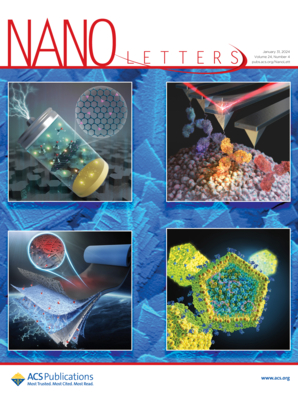Giant Electrocaloric Cooling via Vertically Aligned BCZT Nanoarrays in Relaxor Polymer Nanocomposites for Low-Field Solid-State Refrigeration.
IF 9.1
1区 材料科学
Q1 CHEMISTRY, MULTIDISCIPLINARY
引用次数: 0
Abstract
Thermal management has emerged as a pressing challenge for next-generation electronic devices, as miniaturization and escalating power densities further intensify heat-dissipation issues. Herein, we designed a vertically aligned nanoarray of 0.68(BaZr0.2Ti0.8O3)-0.32(Ba0.7Ca0.3TiO3) (BCZT) embedded in relaxor terpolymer P(VDF-TrFE-CFE) (PVTC) to serve as a three-dimensional conductive network to improve electrocaloric (EC) performance. This EC nanocomposite exhibits exceptional EC performance and high breakdown field (Eb), i.e., isothermal cooling energy density (Q = 2.65 × 107 J·m-3), adiabatic temperature change (ΔT = 12.09 K) and isothermal entropy change (ΔS = 48.7 J·kg-1·K-1) at 80 MV/m electric field, nearly 39 times higher than those of the PVTC. BCZT-nanoarrays act as nucleation sites for dipole alignment under electric field when embedded in PVTC. The dipoles are more easily polarized with an electric field, significantly enhancing EC performance. The phase-field simulations reveal the substantial surface tension of BCZT-nanoarrays promotes the dipole alignment along the z-axis, resulting in large domain volume fraction and large z-axis polarization component. This mechanism improves EC properties while maintaining structural stability.利用垂直排列的BCZT纳米阵列在弛豫聚合物纳米复合材料中实现低场固体制冷。
随着小型化和功率密度的不断提高,散热问题进一步加剧,热管理已成为下一代电子设备面临的紧迫挑战。在此,我们设计了一个垂直排列的0.68(BaZr0.2Ti0.8O3)-0.32(Ba0.7Ca0.3TiO3) (BCZT)纳米阵列,嵌入在松弛聚合物P(VDF-TrFE-CFE) (PVTC)中,作为三维导电网络,以提高电热(EC)性能。在80 MV/m电场条件下,该复合材料表现出优异的EC性能和高击穿场(Eb),即等温冷却能量密度(Q = 2.65 × 107 J·m-3)、绝热温度变化(ΔT = 12.09 K)和等温熵变(ΔS = 48.7 J·kg-1·K-1),比PVTC高近39倍。bczt纳米阵列在电场作用下作为偶极子排列的成核位点嵌入PVTC中。偶极子在电场作用下更容易极化,显著提高了电阻抗性能。相场模拟结果表明,bczt纳米阵列的表面张力促进了偶极子沿z轴的排列,从而导致了较大的畴体积分数和较大的z轴极化分量。该机制在保持结构稳定性的同时提高了EC性能。
本文章由计算机程序翻译,如有差异,请以英文原文为准。
求助全文
约1分钟内获得全文
求助全文
来源期刊

Nano Letters
工程技术-材料科学:综合
CiteScore
16.80
自引率
2.80%
发文量
1182
审稿时长
1.4 months
期刊介绍:
Nano Letters serves as a dynamic platform for promptly disseminating original results in fundamental, applied, and emerging research across all facets of nanoscience and nanotechnology. A pivotal criterion for inclusion within Nano Letters is the convergence of at least two different areas or disciplines, ensuring a rich interdisciplinary scope. The journal is dedicated to fostering exploration in diverse areas, including:
- Experimental and theoretical findings on physical, chemical, and biological phenomena at the nanoscale
- Synthesis, characterization, and processing of organic, inorganic, polymer, and hybrid nanomaterials through physical, chemical, and biological methodologies
- Modeling and simulation of synthetic, assembly, and interaction processes
- Realization of integrated nanostructures and nano-engineered devices exhibiting advanced performance
- Applications of nanoscale materials in living and environmental systems
Nano Letters is committed to advancing and showcasing groundbreaking research that intersects various domains, fostering innovation and collaboration in the ever-evolving field of nanoscience and nanotechnology.
 求助内容:
求助内容: 应助结果提醒方式:
应助结果提醒方式:


